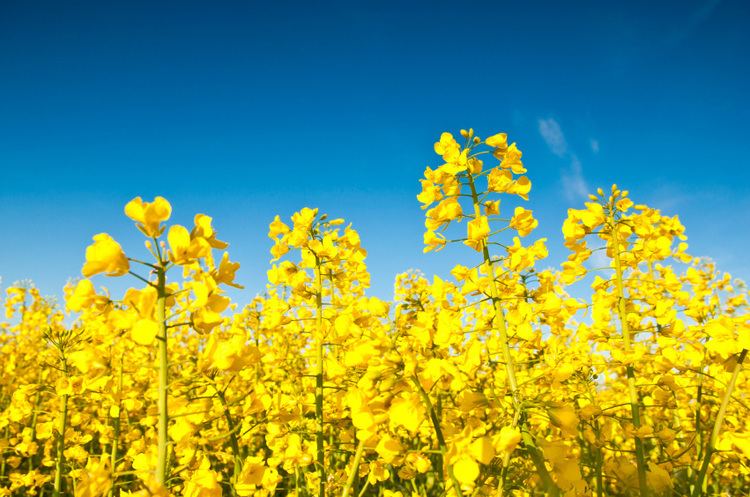 | ||
Similar Cooking oil, Vegetable oil, Soybean, Peanut oil, Safflower | ||
Canola may refer to an edible and industrial oil (also known as canola oil) produced from the seed of any of several cultivars of rapeseed bred to be low in erucic acid from the Brassicaceae family of plants, or to the plants themselves, namely cultivars of Brassica napus L., Brassica rapa subsp. oleifera, syn. B. campestris L. or Brassica juncea. To be called canola, the oil must contain less than 2% erucic acid and the leftover meal must contain less than 30 micromoles of aliphatic glucosinolates per gram.
Contents
- How it s made canola oil
- Etymology
- History
- Production and trade
- Canola oil
- Health information
- Erucic acid issues
- Biodiesel
- Genetic modification concerns
- Legal concerns
- Regulation
- Litigation
- References
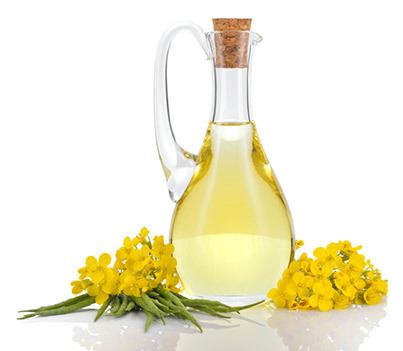
Consumption of the oil has become common in industrialized nations, and it is claimed not only to be completely safe for people to eat, but also to be a health-promoting plant-derived oil having a relatively low amount of saturated fat and a high amount of polyunsaturated fats. Health concerns center around the fact that standard production may leave trace amounts of chemical solvent and that non-organic canola may be made from plants that have been genetically modified. It is also used as a source of biodiesel.
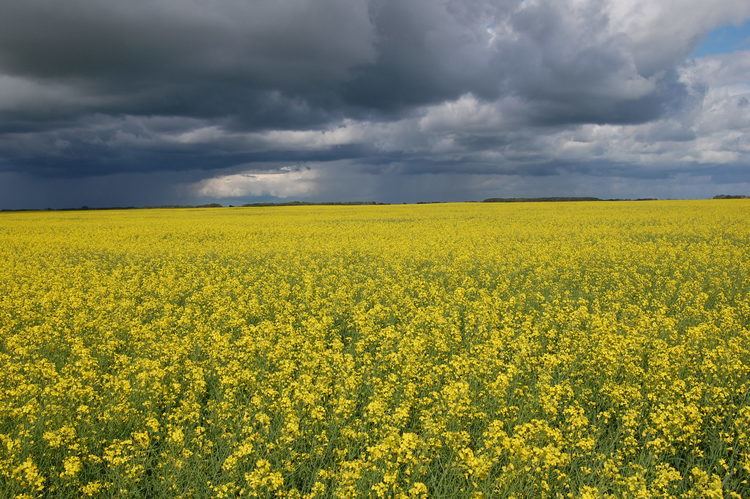
How it s made canola oil
Etymology
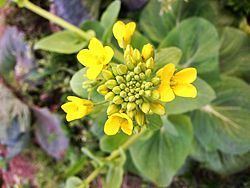
In the 1970s, the Rapeseed Association of Canada chose the name "canola" to represent "Can" for Canada, and "ola" for oil. One dictionary purports that it stands for Can(ada) + o(il) + l(ow) + a(cid).
History
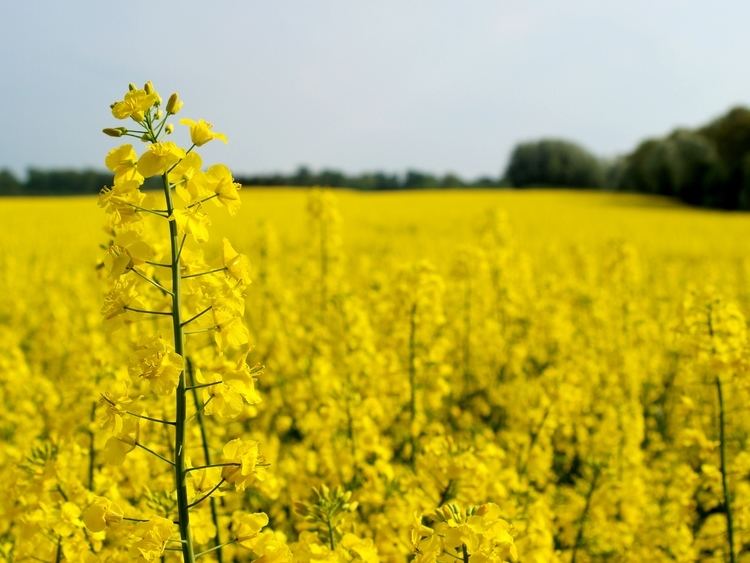
Canola was developed through conventional plant breeding from rapeseed, an oilseed plant already used in ancient civilization as a fuel. The word "rape" in rapeseed comes from the Latin word rapum meaning turnip. Turnip, rutabaga, cabbage, Brussels sprouts, mustard, and many other vegetables are related to the two natural canola varieties commonly grown, which are cultivars of B. napus and B. rapa. The change in name serves to distinguish it from natural rapeseed oil, which has much higher erucic acid content.
Brassica oilseed varieties are some of the oldest plants cultivated by humanity, with documentation of its use in India 4,000 years ago, and use in China and Japan 2,000 years ago. Its use in Northern Europe for oil lamps is documented to the 13th century. Its use was limited until the development of steam power, when machinists found rapeseed oil clung to water- and steam-washed metal surfaces better than other lubricants. World War II caused high demand for the oil as a lubricant for the rapidly increasing number of steam engines in naval and merchant ships. When the war blocked European and Asian sources of rapeseed oil, a critical shortage developed, and Canada began to expand its limited rapeseed production.
After the war, demand declined sharply, and farmers began to look for other uses for the plant and its products. Rapeseed oil extracts were first put on the market in 1956–1957 as food products, but these suffered from several unacceptable characteristics. Rapeseed oil had a distinctive taste and a disagreeable greenish color, due to the presence of chlorophyll. It also contained a high concentration of erucic acid. Experiments on animals have pointed to the possibility that erucic acid, consumed in large quantities, may cause heart damage, although Indian researchers have published findings that call into question these conclusions and the implication that the consumption of mustard or rapeseed oil is dangerous. Feed meal from the rapeseed plant also was not particularly appealing to livestock, because of high levels of sharp-tasting compounds called glucosinolates.
Canola was bred from rapeseed at the University of Manitoba, Canada, by Keith Downey and Baldur R. Stefansson in the early 1970s, having then a different nutritional profile than present-day oil in addition to much less erucic acid.
A variety developed in 1998 is considered to be the most disease- and drought-resistant canola variety to date. This and other recent varieties have been produced using genetic engineering. In 2011, 26% of the acres sown were genetically modified (biotech) canola.
Canola was originally a trademark, but is now a generic term for edible varieties of rapeseed oil in North America and Australia. In Canada, an official definition of canola is codified in Canadian law.
Production and trade
As of the 2013/2014 season, production in the ten leading territories was:
The main price discovery mechanism for worldwide canola trade is the ICE Futures Canada (formerly Winnipeg Commodity Exchange) canola futures contract. Rapeseed is traded on the Euronext exchange.
Canola oil
Canola oil is made at a processing facility by slightly heating and then crushing the seed. Almost all commercial canola oil is then extracted using hexane which is recovered at the end of processing. Finally, the canola oil is refined using water precipitation and organic acid to remove gums and free fatty acids, filtering to remove color, and deodorizing using steam distillation. Cold-pressed and expeller-pressed canola oil are also produced on a more limited basis. About 44% of a seed is oil, with the remainder as a canola meal used for animal feed. About 23 kg (51 lb) of canola seed makes 10 L (2.64 US gal) of canola oil. Canola oil is a key ingredient in many foods. Its reputation as a healthy oil has created high demand in markets around the world, and overall it is the third-most widely consumed vegetable oil.
The oil has many non-food uses and, like soybean oil, is often used interchangeably with non-renewable petroleum-based oils in products, including industrial lubricants, biodiesel, candles, lipsticks, and newspaper inks, depending on the price on the spot market.
The average density of canola oil is 0.92 g/ml.
Health information
A review in 2013 of health effects of canola oil came to overall favorable results, including a substantial reduction in total cholesterol and low-density lipoprotein (LDL) cholesterol, and an increase in tocopherol levels and improved insulin sensitivity, compared with other sources of dietary fat.
Regarding individual components, canola oil is low in saturated fat and contains both omega-6 and omega-3 fatty acids in a ratio of 2:1. It is high in monounsaturated fats, which may decrease the risk of heart disease.
Canola oil has been given a qualified health claim from the United States Food and Drug Administration for lowering the risk of coronary heart disease resulting from its significant content of cholesterol-lowering unsaturated fats; the allowed claim for food labels states:
"Limited and not conclusive scientific evidence suggests that eating about 1 ½ tablespoons (19 grams) of canola oil daily may reduce the risk of coronary heart disease due to the unsaturated fat content in canola oil. To achieve this possible benefit, canola oil is to replace a similar amount of saturated fat and not increase the total number of calories you eat in a day. One serving of this product contains [x] grams of canola oil."
Erucic acid issues
Although wild rapeseed oil contains significant amounts of erucic acid, the cultivars used to produce commercial, food-grade canola oil were bred to contain less than 2% erucic acid, an amount deemed not significant as a health risk. To date, no health effects have been associated with dietary consumption of erucic acid by humans; but tests of erucic acid metabolism in other species imply that higher levels may be detrimental. Canola oil produced using genetically modified plants has also not been shown to explicitly produce adverse effects.
The erucic acid content in canola oil has been reduced over the years. In western Canada, a reduction occurred from the average content of 0.5% between 1987 and 1996 to a current content of 0.01% from 2008 to 2015. Other reports also show a content lower than 0.1% in Australia and Brazil.
Canola oil poses no unusual health risks, and its consumption in food-grade forms is generally recognized as safe by the United States Food and Drug Administration.
Biodiesel
Europe has invested heavily in infrastructure to use canola oil for biodiesel, spurred by EU biodiesel policy initiatives.
Genetic modification concerns
A genetically engineered rapeseed that is tolerant to herbicide was first introduced to Canada in 1995 (Roundup Ready canola). In 2009, 90% of the Canadian crop was herbicide-tolerant. As of 2005, 87% of the canola grown in the US was genetically modified. A 2010 study conducted in North Dakota found glyphosate- or glufosinate-resistance transgenes in 80% of wild natural rapeseed plants, and a few plants that were resistant to both herbicides. The escape of the genetically modified plants has raised concerns that the build-up of herbicide resistance in feral canola could make it more difficult to manage these plants using herbicides. However one of the researchers agrees that ".. feral populations could have become established after trucks carrying cultivated GM seeds spilled some of their load during transportation." She also notes that the GM canola results they found may have been biased as they only sampled along roadsides.
In 2016 a company introduced into the US and Canada a sulfonylurea herbicide tolerant canola variety that was developed using canola's natural oligonucleotide repair mechanisms and targeting glyphosate resistance. They claimed that it was non-transgenic because no foreign genes were introduced and it was indistinguishable from varieties developed naturally by plant breeding.
Legal concerns
Legal issues include whether some countries allow genetically modified canola to be grown, and litigation between farmers and patent holders.
Regulation
There are several forms of genetic modification, such as herbicide (glyphosate and glufosinate, for example) tolerance and different qualities in canola oil. Regulation varies from country to country; for example, glyphosate-resistant canola has been approved in Australia, Canada, China, Japan, Korea, Mexico, Philippines, and the US, while Laurical, a product with a different oil composition, has been approved for growing only in Canada and the US.
In 2003, Australia's gene technology regulator approved the release of canola genetically modified to make it resistant to glufosinate ammonium, a herbicide. The introduction of the genetically modified crop to Australia generated considerable controversy. Canola is Australia's third biggest crop, and is used often by wheat farmers as a break crop to improve soil quality. As of 2008, the only genetically modified crops in Australia were canola, cotton, and carnations.
Litigation
Genetically modified canola has become a point of controversy and contentious legal battles. In one high-profile case (Monsanto Canada Inc. v. Schmeiser) the Monsanto Company sued Percy Schmeiser for patent infringement after he replanted canola seed he had harvested from his field, which he discovered was contaminated with Monsanto's patented glyphosate-tolerant canola by spraying it with glyphosate, leaving only the resistant plants. The Supreme Court ruled that Percy was in violation of Monsanto's patent because he knowingly replanted the resistant seed that he had harvested and also imposing fees of over $200,000 on Schmeiser, but he was not required to pay Monsanto damages since he did not benefit financially from its presence. On 19 March 2008, Schmeiser and Monsanto Canada Inc. came to an out-of-court settlement whereby Monsanto would pay for the clean-up costs of the contamination, which came to a total of C$660.
